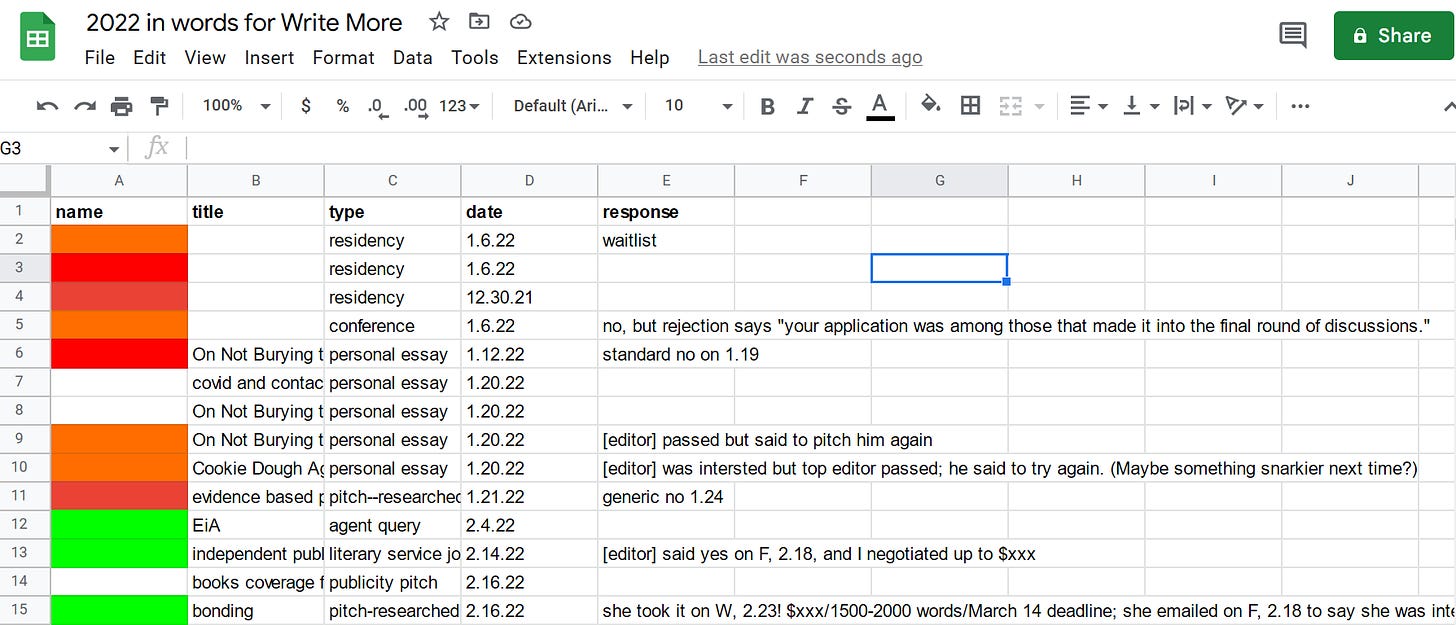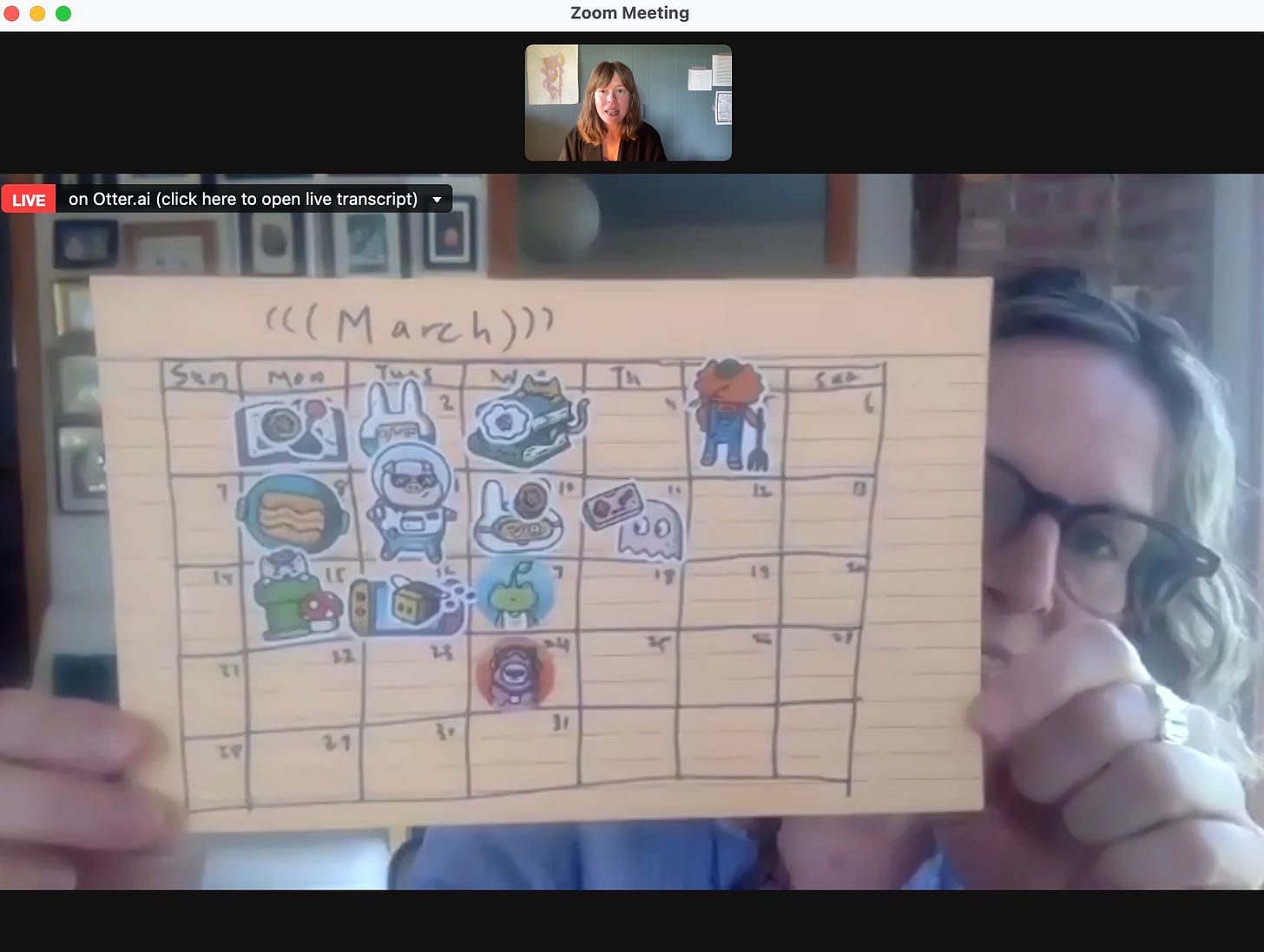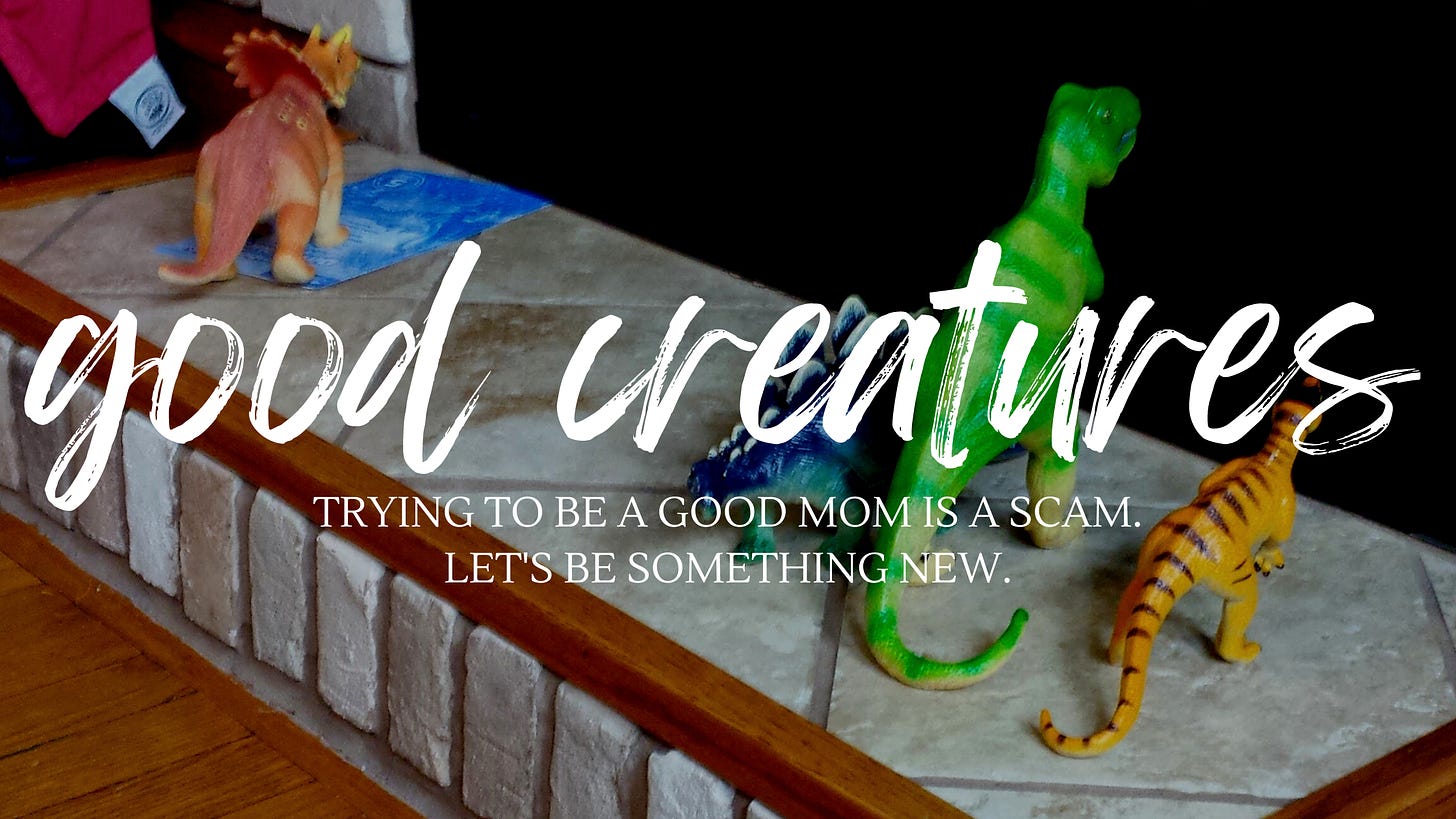Happy New Year, and welcome to Write More! We’re trying something new for the new year—the January Jump Start. Every Sunday in January, you’ll get an email with a tip or strategy to help you set goals and track your progress. If you’re hoping to write more this year, it’s going to be a fun way to get started. So far we’ve talked about crafting a vision and making a vision board, listing what we’re working on and why, and how counting can help you tell if you’re heading in the right direction. Those exercises are all pretty quick, so if you’re just joining us, you might want to go back before diving in to today’s work: making your spreadsheet.
If you want to join us, subscribe here.
Hi friends. I’m writing from a lovely turquoise desk at a discount tire place because my check tire light came on truly three minutes into my drive up to Vermont. If this entry falls apart, let’s agree to blame it on the tire fumes, okay?
Buckle up: today we’re making our spreadsheet.
Here’s the big picture of our work today: writing is a long, meandering, uncertain process, and you need a tool to help you see how hard you’re working. A spreadsheet—either an excel doc or a google sheet—is the easiest tool for our purpose. You don’t need to know anything about formulas or macros (I certainly don’t). All you need to know is what you’re aiming for and what you’ll count to track your progress.

A lot of what I’ll share today comes from an interview with novelist Erin Flanagan, who writes mysteries and thrillers that are smart and twisty and have characters who will stick with you. She’s also very funny. When we talked in early December, she shared the system she and her writing partner Charlotte Hogg use to track their work—and how tracking her time has helped her write more efficiently. (If you’ve been with us really any amount of time, you know that Write More is not about writing faster or discovering hacks to amp up your productivity—but I do think it’s valuable to learn about how you can make the most of the time you have. I learned a lot from Erin that I’m excited to share with you.)
this week’s exercise: setting up your spreadsheet
Start with your calendar. For whatever period of time you’re working with, whether that’s a month, a season, or a semester, count the number of days you have available for writing. When Erin shared this as her starting point, this was a revolutionary tip for me. Instead of pretending that we’re automatons with infinite time available that we just have to learn to manage better, let’s start by taking into account what’s actually possible. So cross off the days you have long meetings or your kids have a soccer tournament or you have a family birthday party. You don’t need to have a full, uninterrupted day to get some good writing done—but you also don’t need to stress yourself out by expecting yourself to write for 10 hours in a week full of work deadlines and parent-teacher conferences and doctor’s appointments.
Given the time you have available, what do you think you can get done? If you haven’t typically tracked time with your writing process, you may not know. That’s fine! That’s one of the things you’re going to learn. Erin shared that she’s learned, through a couple years of time tracking, approximately how many words she can write an hour, and she’s learned how to pretty accurately estimate how long revisions will take.
Decide what you want to track. As we talked about last week, these are your lead measures—the work you’re putting in.
The two most obvious ways to think about tracking your writing process are in terms of words or time. To help you decide, you could think about what stage of the writing process you’re in. Erin shared that she tracks word count when she’s drafting, then time when she’s revising.
You might also think about what you’re hoping to learn about your writing process. I’m trying to get better at estimating how long it takes me to write analytical/researched prose so I can make decisions about which kinds of projects to take on. You might have other goals or questions, and yours might be more qualitative—things like how much writing time a week is optimal for you to feel like a balanced and happy person? how long do you need in a writing session to settle in and find your groove?
Set up the spreadsheet. Last year, I kept a couple different sheets within a google sheet I called “2022 in words.”
On one sheet I recorded all my pitches and submissions, and I color-coded and added notes as I heard back. (Red for no, orange for a not this time/try again kind of answer, green for yes, plus any feedback or other info I wanted to recorded.) I’ll share a snippet of that sheet below, in case it’s helpful to actually see one example. (In my full version, the name column has info it; I thought you could get the general picture here without seeing the specifics of places I’ve been rejected recently. I’ll also say, if you’re newer to submitting, that this number of rejections (I had so many more over the course of the year!) is totally fine and normal. Those red and orange bars are evidence of your effort.)
I also kept a “monthly tally” sheet with that month’s data—# of pitches/submissions/etc and what happened with them, things I’d published, other professional things like workshops I’d taught or people I’d connected with. These are lag measures—what I actually produced or accomplished that month. I found the monthly tally helpful for reflection. Even in months that feel hectic, where your work feels scattered, chances are you’ve accomplished more than you think, and it’s nice to talk a moment to count that all up. (I jot things down in my paper planner as the month goes on, then transfer that info into the spreadsheet at the end of the month.)
This year, I’m going to work on tracking time and word count. It’s something I’ve done from time to time, but have never stuck with consistently. Erin really sold me on the benefit of time tracking as a way to learn about your writing process, so my spreadsheet this year will include a time tracking sheet as well. I’ll have columns for date, project, time, word count, and notes—things like what I accomplished, how it felt, and so on.
One big idea here is that tracking is a way of learning about your writing process and honoring your effort, not a form of competition or a tool to scold yourself for not working hard enough. Writing is so hard and can be so dispiriting at times; a spreadsheet can be a really helpful way to see your progress along the way.
If you set up a spreadsheet, I’d love to hear about it! Feel free to share what you’re tracking or how you’re reflecting on your hard work.
okay, but what if even thinking about a spreadsheet makes all your creative energy leave your body?
Two other ideas
Be like Catherine Newman and make yourself a sticker chart. (She shared it in her interview with Molly Wizenberg, in Molly’s newsletter, I’ve Got a Feeling. This is the chart she used while she was writing We All Want Impossible Things, easily one of my favorite books of the past many years!)
Danielle Lazarin’s essay, How to Track If You’re Writing “Enough,” describes a more flexible, qualitative approach of using Xs on a paper chart. (You can click through for a description + pictures.)
I’ll be back next Sunday with the big reveal from Erin Flanagan—how tracking her time helped her learn about herself as a writer—and some thoughts on setting up a rhythm for your writing life.
this week!
Reading & Conversation with Emily Pérez at White Whale Bookstore (online), W, January 25th, 7pm eastern
My Long Devotion co-editor Emily Pérez and I are reading together virtually at White Whale this Wednesday at 7pm eastern, and I’d love for you to join us. We’ll be sharing poems from our most recent books and talking about writing and mothering and sustaining a creative practice. If you’re someone who’s working to create a sustainable creative practice alongside all the other wonderful, overwhelming parts of your life, I think you’ll really love it. You can find a facebook invite for the event here (invite a few friends, while you’re at it!) or go right to the EventBrite link here. I'd love to see you there!
The Long Devotion at a Hundred Pitchers of Honey reading was so wonderful, and if you missed it, you can catch it on YouTube.
I cried, Joyelle McSweeney all but sang her amazing sestina, and all in all, it was the best, most inspiring 45 minutes of my recent life. (That’s right—6 poets, 12 poems, just 45 minutes, jampacked with wonder and love.)
a quick programming note: Good Creatures!
For the past little bit, I’ve also been quietly and very sporadically writing another newsletter, Good Creatures, and I decided to bring it under the banner of this newsletter as a section. Good Creatures is a space where I share the reading and research and thinking I’m doing around mothering, and I’m hoping it will go out once a month. If you liked the piece I wrote about Kate McCallister, the mom from Home Alone, or my article about the wild origins of our ideas about bonding, I think you’ll love it. But if you don’t want to receive it (no hard feelings!) this article will tell you how to unsubscribe from that section but still get the main Write More content.
Write More, Be Less Careful is a newsletter about why writing is hard & how to do it anyway. I’d love to hear from you. Reply to this email, comment below, or find me on twitter (@nancy_reddy) and instagram (@nancy.o.reddy).
If you’ve enjoyed this newsletter, I’d love it if you would share it or send it to a friend.










I like this spreadsheet idea, Nancy (and Erin). I've been overwhelmed by all the "to dos" of revising my manuscript (fourth round, this time it's for reals), and haven't been able to get started. So there's my 292 pages just sitting in the corner waiting for me to get off my duff.
As for the spreadsheet, I've set it up with a separate sheet for reach month. Column headers include "Activity," "Date," "Pages Read or Revised," "Time," and "Notes." I have a separate sheet for "Goals" for each month (for the next three months) - will adjust as needed at that point.
Thanks for the ideas and the inspiration. P.S. The lead time and lag time explanation was super helpful and brilliant!